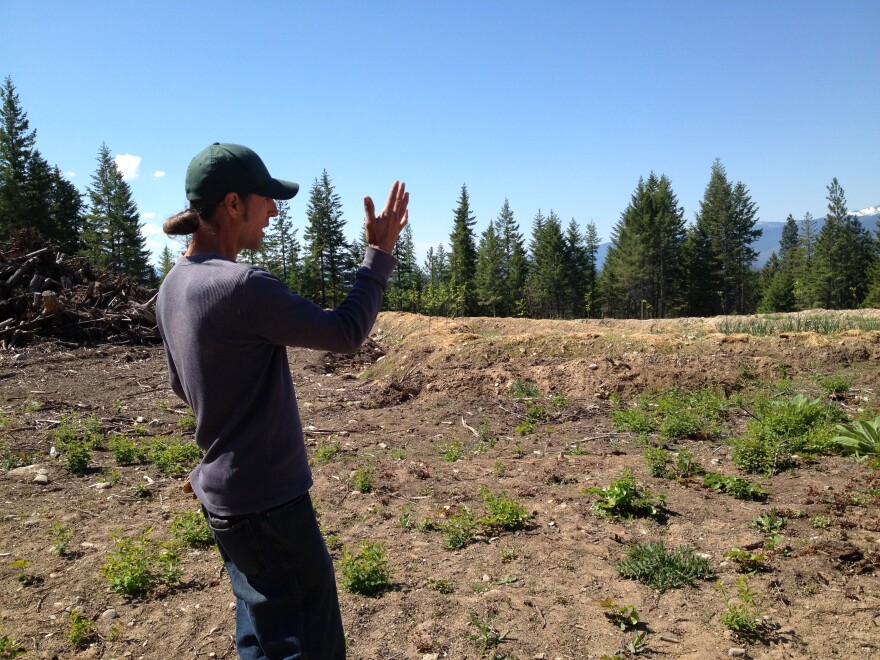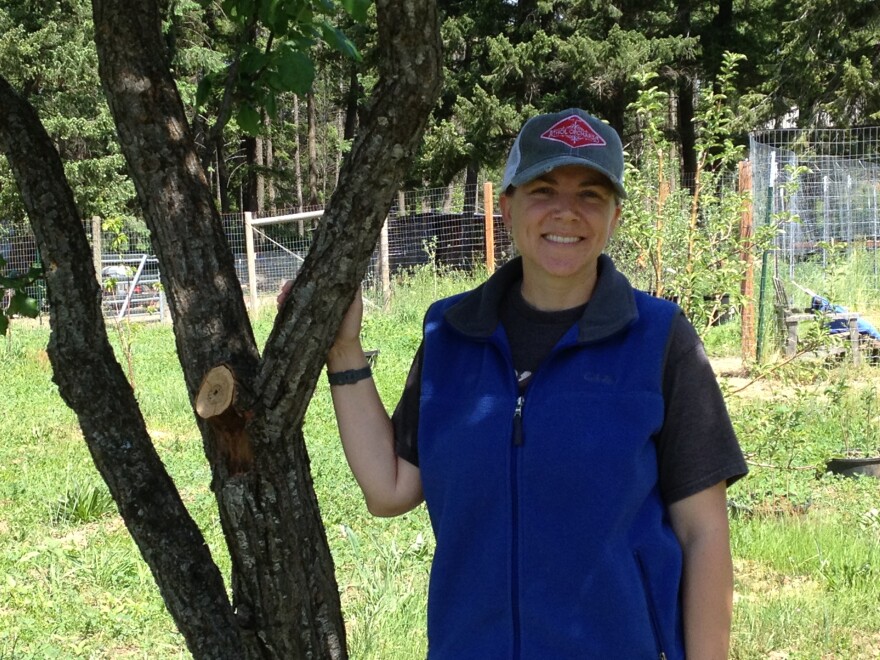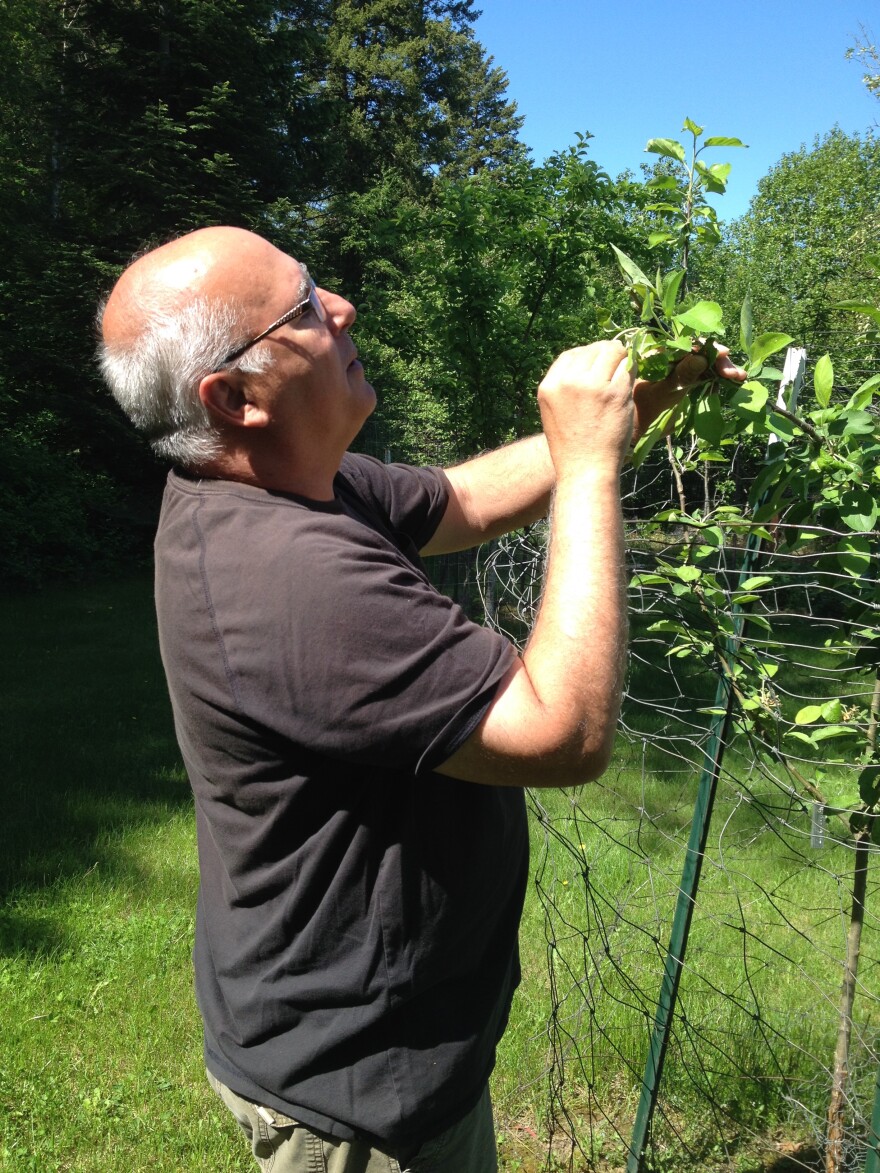Around the first of the year, I allow myself the luxury of going back to listening to some of my stories from the past year. And then I give myself permission to re-run my favorite. This time, I’ve picked a story about a Chattaroy man who is using his skills as a retired law enforcement investigator to help discover old varieties of apples that used to grow in our region and to bring them back. As part of that story, we talked with two apple growers in north Idaho who have that same passion for preserving heritage varieties.
Our story first aired last May. We started with Dave Benscoter, who has helped farmers and others in Whitman County, where he grew up, with their Lost Apple Project. But he has his own small orchard, near the base of Mount Spokane.
“I’ve got probably about 30 trees, 10 here and then a bunch across the creek, and I think I’ve got about 40 different varieties just on this tree alone,” Benscoter said.
Yes, a tree that started bearing only golden delicious apples is now capable of bearing about 40 varieties, many you’ve probably never heard of.
“Karmijn de Sonnaville. Virginia Gold. I’ve got Palouse apples here. I’ve got one or two of the lost varieties. I’ve got Fall Jeneting. That was just discovered about six years ago," he said.
How does this happen? Every spring, Benscoter grafts branches from different varieties of apple trees onto the branches of his trees.
“I’ve been actually trading what they call apple scions — or grafting wood — with people around the country for about five or six years now. Other people across the country are just as crazy as I am and they like to try these old varieties too," he said.
Every branch that’s fused bears the variety of the newly-grafted branch.
“Yeah, it kind of looks like Christmas out here with all the different colors, red and orange and yellow and green, during the fall," Benscoter said.
Benscoter’s interest in apples came after he retired. A neighbor asked if he would come and pick apples from her trees. They sit in an unusually fertile area right near her well and no one had pruned the trees for years. So he trimmed them that fall and planned to come back the next year.
“And then that winter I just started researching. I just kind of got the bug. I didn’t know what kind of apples they were so I called her and she knew one variety, a yellow transparent, was in the orchard. And she called her brother and her brother knew that wealthy was another apple, but that was it,” Benscoter said.
Benscoter used his investigative chops, finding old county maps and other documents, to help him pinpoint apple varieties. In fact, he and a guy in Troy, Idaho recently used some of those techniques to find what they believe may be trees with lost apple varieties near Troy.
Benscoter believes there are about 17,000 named varieties of apples in the U.S. He says many originated back east and have been lost.
“But the really good varieties have stayed with us, even from the very first pilgrims, a few varieties have stayed with us through history. Two thousand of those trees have been rediscovered, but some of those apples have been lost again and so, what we want to do is, with the apples that we’re finding out here in eastern Washington and northern Idaho, is to, when we find a tree, we don’t want it to get lost again,” he said.
An organization in Molalla, Oregon called the Temperate Orchard Conservancy has become kind of a fact checker for apple varieties.
“They do all of my apple identification too," Benscoter said. "We send them scions and they graft them to small trees there, so we can be assured that we’re not going to lose these varieties again.”
Benscoter has developed a network of heritage apple enthusiasts, with whom he consults when they have questions about apples they’re discovering.

“I live up here in beautiful Bonners Ferry, Boundary County, Idaho, about eight miles north of Bonners Ferry , up on a bench, about 2,700 feet, I think,” said apple grower Casimir Holeski.
Holeski — and several of his dogs — lead me to a three-acre area he cleared last summer for an orchard. He’s got fruit and nut trees in rows with plans to get more in this summer. He says his is one of the few orchards in a place that was once full of them.
“A hundred years ago there were literally orchards, the old timers that I’ve talked to tell me there was orchards from the rock cut at the hospital, basically the city limits, all the way out to the border. It’s like any spot that was marginal land, they put trees in, they put orchards in. We were shipping apples to England,” Holeski said.
But, he says, some bad weather along the way and a decision to focus the Northwest apple industry on central Washington essentially shuttered the orchards in Boundary County. But many trees are still standing and Holeski believes the county could again become a fruit producer.
“I’m trying to build this grassroots movement to fill this valley with trees again, all this marginal land. We don’t need to compete with the valley farmers, but we want to grow tree crops again, nuts," he said. "The things I know for sure, rock solid, apples, 120-year-old apples. They haven’t been touched by a human in decades. They’re being climbed by bear, browsed by moose, elk, deer. They’re producing like crazy up in the right spots, 120 years later. Pears the same way. I find lots of old plums. Black walnuts, a hundred years plus.”
Holeski says a growing local food movement could bring vibrancy to the economy, keeping nature’s bounty in the area and allowing people to buy produce grown near their homes. He envisions a local co-op.
“We pool our resources for things like cracking equipment for nuts, cider press for cider, right? We work together. We create a bunch of growers, a bunch of value-added producers and a bunch of support businesses. That’s the goal. Create an orchard industry. Bring it back across the border. Creston Valley, are you familiar with that area? They experienced some of the same adversities and they just didn’t stop. They kept going. Lots of fruit up there. We can do the same thing," Holeski said.
And part of the strategy is to preserve and grow some of those older varieties of apples so that people can eat and fall in love with them. The challenge, he says, is to find and identify them again.
“Red delicious, yellow delicious. I can identify those. So it’s basically just been diving in, talking to other people who are passionate, different experts, running things by them," Holeski said. "I’m connected to groups on Facebook, the North American Fruit Explorers. I do a lot of research, looking at books, looking at pictures, looking at descriptions.”
And he has connected with Dave Benscoter, whom we met earlier. Benscoter has referred him to the Temperate Orchard Conservancy in Oregon to see if there may be a variety or two there that had been forgotten.
“I’m looking for beauty and I like all the different colors. I like all the different shapes and textures and all that. Different ripening times. But at the top of it is flavor," Holeski said. "I want to take a bite and say wow. I want to give it to my dad or one of my friends and I want them to ‘Whoa!’, you know, have an experience that is extraordinary or memorable.”
You can find more about Holeski’s work on Facebook: the Boundary County Orchard Restoration Project.
About an hour south of Casimir Holeski’s orchard is Athol Orchards.

"I grew up around apples and immersed in a town that loved apples and supported apple history," said Nikki Conley, co-owner of Athol Orchards, north of Coeur d'Alene. "We came here in 2016, established our farm in 2016. We’ve added apple trees every spring up until this year; we’re adding more.”
It’s the perfect place to establish a new orchard, given its previous history.
“The original homestead orchard that used to be here included this plum here, the old apple trees out front. There were a few other apple trees. This was an old Rainier that we lost last year, cherry tree. And then there’s an old Bartlett pear out there," Conley said. "The neat thing is if you were to walk out there, there’s basically an old stump field where they used to be an old homestead orchard. I didn’t tear out the stumps because, to me, that’s part of history and it reminds you of what used to be here.”
You’ve heard of barn raising parties. On Earth Day, Conley and her husband and daughters invited friends and neighbors over for an apple tree planting party. They put in 100 trees that grow older varieties of apples.
“A lot of these trees we’re growing go back as far as 400 years. So some of the varieties are from the 1600s, 1700s, 1800s and they all have specific uses for them. Planting apple trees back in the day wasn’t just for fun or to have some fruit. People actually grew them for very specific reasons," Conley said. "The qualities of these apples may not be the prettiest and the flavors might be different and what people don’t recognize, but there’s a lot of characteristics that we miss out on because the commercial growers won’t grow them. They just aren’t financially feasible.”
Conley had to carefully choose the types of trees that would do well in her farm’s microclimate, cooler than Coeur d’Alene to the south. She says some of them came from Maine, which has a similar climate.
Conley has developed a friendship with Dave Benscoter, the apple detective. He’s taught her how to graft branches of other apple varieties onto her trees. He brought her rootstocks of older trees to plant in her orchard. They share the mission of preserving forgotten varieties.
“You go to the store and pick up an apple, there’s no history behind it and it doesn’t really matter. What we aim to be is a living history farm. We want to do some educational elements out here; have kids learn about the history of apples, learn about how to make an apple pie, where the ingredients come from for an apple pie. We even do some sugar-making here. We have some maple trees and we tap our own maples and make our own maple syrup. It’s pretty amazing,” Conley said.
They also make apple cider syrup, which is sold in local farmers markets and shipped around the country. It’s the product that helps to finance the farm. But it’s more than a commercial enterprise for her.
“I think, for me, this is kind of like an apple museum. That’s the way that I look at our farm. I’m wanting to share that history with the community,” Conley said.
You can learn more about Athol Orchards on their Facebook page.

